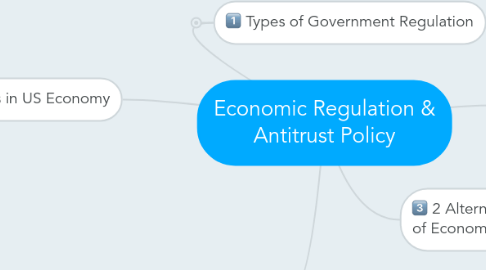
1. Types of Government Regulation
1.1. Market Power
1.1.1. ability of a firm to raise its price without losing all its customers to competitors
1.2. Types
1.2.1. Social Regulation
1.2.1.1. government regulation to improve health & safety
1.2.2. Economic Regulation
1.2.2.1. aims to control the price, output, entry of new firms, and service quality
1.2.2.2. in industries where there is a natural monopoly
1.2.2.3. examples
1.2.2.3.1. local electricity transmission
1.2.2.3.2. subway system
1.2.2.4. Antitrust Policy
1.2.2.4.1. outlaws attempts at monopoly or oligopoly
1.2.2.4.2. fosters competition in markets where competition is desireable
2. Regulating a Natural Monopoly
2.1. Unregulated Profit Maximization
2.1.1. government can force monopolist to lower price & increase output.
2.1.1.1. ways to accomplish:
2.1.1.1.1. government operate the monopoly
2.1.1.1.2. government regulation
2.1.1.1.3. public utility
2.2. Setting Price = Marginal Cost
2.2.1. short-run: results in an economic loss to monopolist
2.2.2. in long-run, would rather go out of business
2.3. Subsidizing the Natural Monopolist
2.3.1. involves the government subsidizing monopolist so he can earn a normal profit
2.3.1.1. bus & subway tickets are priced below AC & subsidized by government to profitable level
2.3.1.2. must be paid for by either:
2.3.1.2.1. increasing taxes
2.3.1.2.2. decreasing spending
2.4. Setting Price = Average Cost
2.4.1. Average cost curve includes normal profit
2.5. Regulatory Dilemma
2.5.1. Set price equal to?
2.5.1.1. marginal cost
2.5.1.1.1. socially optimal
2.5.1.1.2. but requires a subsidy
2.5.1.2. average cost
2.5.1.2.1. less than socially optimal output
2.5.1.2.2. higher than socially optimal price
3. 2 Alternative Theories of Economic Regulation
3.1. economic regulation is in the public interest
3.1.1. promotes social welfare keeping prices down
3.2. economic regulation is in the special interest of producers
3.2.1. limiting entry/competition
3.3. Special interests, regulation & degregulation
3.3.1. entry restrictions reduce competition & increase prices
3.3.2. capture theory of regulation
3.3.2.1. regulation is acquired by the industry and operated for its benefit
3.3.3. deregulation has been in public interest
3.3.3.1. deregulation enables
3.3.3.1.1. new entry for competitors
3.3.3.1.2. new ways of doing business
3.3.3.1.3. benefits to consumers
4. Antitrust Law & Enforcement
4.1. antitrust policy attempts to promote socially desirable market performance
4.2. Origins of Antitrust Policy
4.2.1. 2 most important economic developments of 19th century
4.2.1.1. manufacturing technology
4.2.1.2. growth of railroad
4.2.2. Sherman Antitrust Act 1890
4.2.2.1. 1st national legislation in the world against monopoly
4.2.2.2. law prevented
4.2.2.2.1. trusts
4.2.2.2.2. restraint of trade
4.2.2.2.3. monopolization
4.2.3. Clayton Act 1914
4.2.3.1. enacted to cover anticompetitive practices not covered by Sherman Act
4.2.3.2. outlaws
4.2.3.2.1. price discrimination
4.2.3.2.2. tying contracts
4.2.3.2.3. exclusive dealing
4.2.3.2.4. interlocking directorates
4.2.3.2.5. acquiring corporate stock of competing firm
4.2.4. Federal Trade Commission Act 1914
4.2.4.1. established the FTC to enforce antitrust laws
4.2.5. Celler-Kefauver Anti-Merger Act
4.2.5.1. prevents one firm from buying the physical assets of another firm to reduce competition
4.2.5.2. can block 2 types of mergers:
4.2.5.2.1. horizontal
4.2.5.2.2. vertical
4.3. Antitrust Enforcement
4.3.1. consent decree
4.3.1.1. without admitting guilt
4.3.1.2. firm agrees to quit doing what it was charged with if charges are dropped
4.4. 2 Interpretations of Antitrust Law
4.4.1. Per Se Illegal
4.4.1.1. illegal regardless of the economic rationale or consequences
4.4.2. Rule of Reason
4.4.2.1. before ruling, courts may look at 2 things:
4.4.2.1.1. reasons why the offending practice was adopted
4.4.2.1.2. its effect on competition
4.4.2.2. predatory pricing
4.4.2.2.1. pricing to drive others out of business
4.4.2.2.2. Price < MC
4.5. Mergers & Public Policy
4.5.1. regulators challenge any merger that would create, enhance, or entrench market power
4.5.2. Herfindahl-Hirschman Index(HHI)
4.5.2.1. a measure of market concentration
4.5.2.2. the more firms & more equal their size, the smaller the HHI
4.5.2.3. Government challenges any merger which meets 2 conditions:
4.5.2.3.1. HHI > 2,500 and
4.5.2.3.2. the merger increases the index by > 200 points
4.5.2.4. Calculatation
4.5.2.4.1. square the % market share for each firm
4.5.2.4.2. sum the squares
4.5.2.4.3. index < 1,500 rarely challenged
4.5.3. 2 categories
4.5.3.1. Horizontal mergers
4.5.3.1.1. firms in the same market
4.5.3.1.2. of more interest for antitrust
4.5.3.2. Nonhorizontal mergers
4.5.3.2.1. all other types
4.6. Merger Waves
4.6.1. conglomerate merger
4.6.1.1. merger of firms in different industries
5. Competitive Trends in US Economy
5.1. Competition over time
5.2. Recent competitive trends
5.2.1. growing world trade
5.2.2. technological change is boosting competition
5.3. Problems with Antitrust Policy
5.3.1. Market may not require that many firms
5.3.2. antitrust abuses
5.3.3. growth of international markets
5.3.4. bailing out troubled industries
